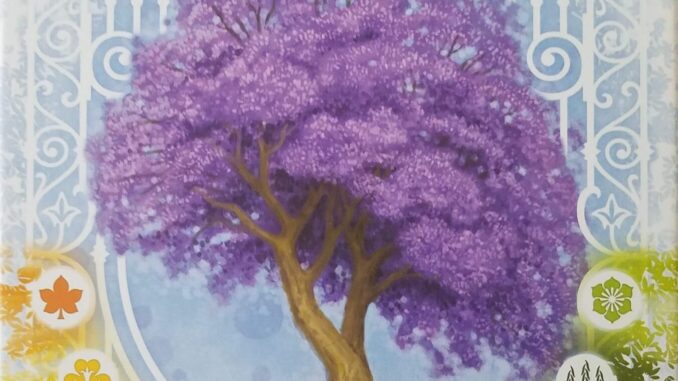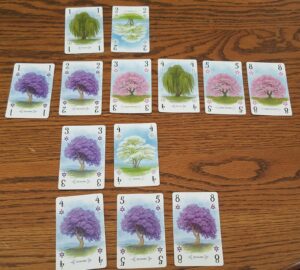
Do you need to unwind? Does a nice stroll through the woods sound like a good way to relax? Aren’t those some nice trees? You know what would be fun? Competing with your friends to find the best path through the trees and scoring points based on that path? No? Well, how about if you did that in a card game? Enter Arboretum from Renegade.
Gameplay- A
As hinted above, the idea for this game is to score the most points, which you do based on a path through the arboretum. You take turns placing trees down in your personal arboretum. There are up to ten different types of trees each with a number value 1-8. Paths are made from the lowest numerical value of a type of three to the highest. On the path you can have any trees, but each one must be of a higher number than the one before. You do not have to go sequentially, ie you can skip from 1 to 5, but you can’t go laterally or lower, ie no 3 to 3 or 3 to 2. Furthermore, to score a path, you must have the highest value of that tree in your hand at the end of the game.
 In this example of a completed board, the player has four potential chances to score. He has a path for the Dogwood (white) from the Two through the Cherry Blossom Three and ending at the Four. That would score three points. The Willow (green) could go from the One through the Dogwood or Jacaranda Two, Cherry Blossom Three and ending with the Four. That would score five points; four for the path plus one for starting with One card. The Cherry Blossom (pink) path could score six points, a path of four cards from the Three to the Eight, with two bonus points for ending on the Eight. And the Jacaranda (purple) would score a whooping fifteen points. If you have four or more in a path of the only a single tree type each card in the path is worth double points; six cards for twelve points, plus two bonus for the Eight and one for the One.
In this example of a completed board, the player has four potential chances to score. He has a path for the Dogwood (white) from the Two through the Cherry Blossom Three and ending at the Four. That would score three points. The Willow (green) could go from the One through the Dogwood or Jacaranda Two, Cherry Blossom Three and ending with the Four. That would score five points; four for the path plus one for starting with One card. The Cherry Blossom (pink) path could score six points, a path of four cards from the Three to the Eight, with two bonus points for ending on the Eight. And the Jacaranda (purple) would score a whooping fifteen points. If you have four or more in a path of the only a single tree type each card in the path is worth double points; six cards for twelve points, plus two bonus for the Eight and one for the One.
To score any of those paths you would need to have in your remaining hand of seven cards, the most of that tree type. Looking at the Jacaranda (purple) path, the only cards unplayed are the Six and Seven. If this player had the Six, but another player had the Seven, the second player would be able to score his Jacaranda path, which would be worth zero, as he couldn’t have any in his arboretum. That can be a tactic, denying points to your opponent for this big scoring trees.
Note, it is total value of the cards in your hand. If you have the Three and the Four of a tree, and your opponent has the Six, you win because your value is seven. Also, if someone has the One in their hand, the Eight is worth zero points in your hand. It is very important to pay attention to which of each card has been played. If you want to score a path, and are holding onto the Eight, it might be worth nothing.
Gameplay is done via turns, where each player draws two cards, plays one in their arboretum, and then discards one. The card played must be next to another card already in play (beyond the first, obviously). You do not have to place cards sequentially, ie a Two can go next to a Seven, but the path must count up. But your path can be in any non-diagonal direction. Each player has their own arboretum and their own discard pile.
When you draw a card, you can either do it from the draw pile, which will be a random card, or the top card of any players’ discard pile. This means you have to be careful what you discard as other players might pick it up to benefit their own arboretum. My first game, I score a ton of points on Royal Poinciana (red) because everyone threw them away and I just picked them up to play. We didn’t know what we were doing that first game.
Production- B+
The cards are sturdy and should hold up for awhile with the minimal amount of shuffling that is required (just once at the start of the game). The box is a little bigger than it needs to be, as you could just have a box the size of a regular deck of cards. But it does allow for a great cover art and a scorepad which helps break down scoring at the end.
Theme- A

The artwork lets each tree standout on its own so they are readily identifiable, typically by a fairly unique color. Seeing as they are all trees, non-naturist like myself would expect them to all be green. But the designers selected a variety of trees with unique colors, at least when they bloom or that they change to in the autumn. It gets you wishing you could really walk through an arboretum with all these different trees in bloom at once. But I expect, even if they could all grow in the same climate, they wouldn’t bloom at the same time.
Expansions- TBD
Not that kind of game.
Conclusion- A-
The game flows fairly well, though you can easily fall into the indecision paralysis as you worry about screwing yourself up with which cards you play versus discard versus keep in your hand for scoring. But since your main decision is straightforward, play one card, it doesn’t bog things down. The main stumbling block is the contrast between theme and game tactics. You’re taking a nice, peaceful stroll through some beautiful trees. That evokes a relaxing experience. But, to win, you can do so by being a right bastard and aiming to deny your opponents points by winning their most valuable path. That adds a layer of cutthroatness that is at odds with the peaceful nature. It’s not game ruining or anything. It is a fun game to play with a small group, especially if you enjoy some pleasant artwork to look at while you play.


